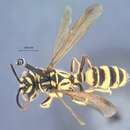Comprehensive Description
(
Inglês
)
fornecido por Smithsonian Contributions to Zoology
Cerceris rufonigra turrialba
FEMALE.—Length 12 mm. Body slender; black with yellow markings covering close to 50 percent of the body surface; punctation average to coarse; pubescence very short.
Head about one-third wider than the thorax; yellow markings cover much of the head, leaving the following areas black: an irregular area embodying the ocelli with extensions to the compound eyes and to the antennal scrobes, a black band extending from the posterior border of one eye to that of the other eye passing through the occiput, and an oval black patch on the genae surrounded by yellow; the clypeal border is amber, has three indistinct low denticles on the medial lobe, and a low carina near the junction of the medial and lateral lobes; the clypeal process border has two separated depressed lamella, dorsad of which there is a band of short bristles; mandibles very long with one large denticle near the apex, basad of which there are three low denticles; mandibles largely yellow with the apex and denticles fuscous; antennae normal in form, ferruginous with a yellow patch on the scape.
Thorax black except a divided band on the pronotum, two elongate stripes dorsally and two more lateral patches cephalad of the tegulae on the scutum, scutellum with two lateral patches, the metanotum, small patch on the tegulae, the propodeum exclusive of an elongate black area, most of the pleuron and ventral parts of the thorax, all of which are yellow; tegulae normal in form; enclosure heavily ridged; mesosternal tubercles appearing as two distinct denticles, one above and one below the epiplural suture with the corresponding sclerites considerably inflated; legs largely yellow except for dark stripes along the trochanters, femori, and tibiae; wings subhyaline.
Abdomen largely yellow with black bands on terga 1 and 2, black patches along the mesal anterior borders of terga 3, 4, and 5; venter yellow; pygidium as illustrated (Figure 131d), yellow but darker at the apex.
MALE.—Length 10 mm. Body slender; black with markings very similar to the female; punctation average; pubescence very short.
Head subequal in width to the thorax; yellow except for the following black areas: an irregular area embodying the ocelli with extensions to the compound eyes and antennal scrobes, a black band extending from the posterior border of one compound eye to that of the other eye and passing through the occiput, and a small black spot on the genae surrounded by yellow; clypeal border amber with three very indistinct elevated carina on the medial lobe; hair lobes extending over the lateral two-thirds of the lateral clypeal lobes; mandibles without denticles, largely yellow but with the apex and margins darker; antennae normal in form, ferruginous to fuscous with a yellow patch on the scape.
Thorax with a color pattern like that of the female; enclosure ridged as in the female; mesoplural tubercles absent but the mesopleural sclerites inflated as in the female; legs and wings as on the female.
Abdomen with yellow markings as on the female, that on tergum 6 being similar to the color pattern on terga 3, 4, and 5; pygidium as illustrated (Figure 131g), yellow except for darker apex.
TYPES.—The type female, taken from Turrialba, Costa Rica, 2080 feet elevation, 24 July 1963, and the allotype male, taken from 6 miles west of Turrialba, Costa Rica, 3800 feet elevation, 17 July 1963 (both by H. A. Scullen and Duis Bolinger), are at the National Museum of Natural History (USNM 71073). Paratypes are as follows:
CENTRAL AMERICA: COSTA RICA: ♂, Heredia, Puerto Viejo, 100 m, 1 August 1964 (MGN); ♀, Turrialba, 2080 ft, 22 July 1963 (S and B); ♂, same locality, 31 July 1963 (C and I); 4♀, 75♂, 6 mi W Turrialba, 13–17, 21, 23 July 1963 (S and B). PANAMA: ♀, Potrerillos, 3 May 1935 (GEB); ♀, Barro Colorado Island, 4 March 1937 (SWF); 2♀, ♂, same locality, 27 April, 7 June 1952, 12 February 1955 (CWR); ♀, Chiva Chiva Trail, 18 November 1923; ♀, Mount Hope, 8 July 1924 (NB).
SOUTH AMERICA: COLOMBIA: ♀, near Medellin, 5700 ft (NW); ♀, ♂, Restrepo, Meta, 500 m, 1936 (JB); ♂, Santo Domingo, 8 September 1930 (RB).
DISTRIBUTION.—Costa Rica south to Colombia, South America.
PREY RECORD.—None.
PLANT RECORD.—None.
- citação bibliográfica
- Scullen, Herman Austin. 1972. "Review of the genus Cerceris Latreille in Mexico and Central America (Hymenoptera: Sphecidae)." Smithsonian Contributions to Zoology. 1-121. https://doi.org/10.5479/si.00810282.110

